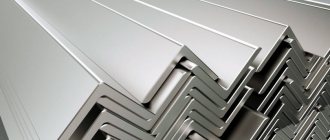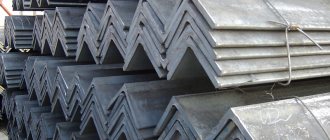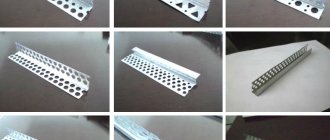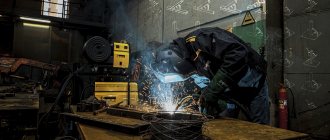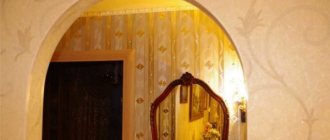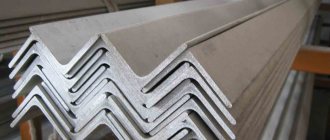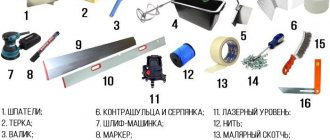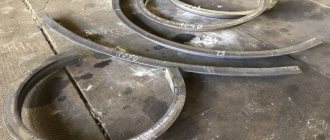Steel equal-flange angle is one of the most common and popular types of shaped metal products. Manufactured in accordance with GOST standards 8509-93 and 19771-93 from carbon or low-alloy steels, according to the manufacturing method it is divided into hot-rolled and bent. A steel blank with a square cross-section is used as a blank for a hot-rolled angle; the dimensions of the flange in such products can range from 20mm to 250mm. A bent corner is produced by bending a metal strip, which in turn can also be hot-rolled or cold-deformed. The dimensions of the bent corner shelf according to the GOST 19771-93 standard can range from 36mm to 160mm.
The length can be up to 12 meters. In construction, corners are used to solve a variety of problems, from reinforcing the foundation and arranging the roof to finishing premises, as they are highly durable, reliable and durable, have less weight and are cheaper compared to profile square pipes and solid products of the same size. The selection of the angle is carried out based on the results of calculations for deflection and bending, which also makes it possible to determine the maximum permissible load.
Which is better: a profile pipe, a channel or an angle?
Profile pipe, channel and angle are used very often in construction. These types of rolled metal can be interchangeable; their competition with each other is inevitable. Therefore, when creating a metal product, the question arises which of these three types of rolled products to use. What is better: a profile pipe, a channel or an angle? First, let's figure out what these types of rentals are and what they are.
Profile pipe
Positive aspects of this product:
- Symmetrical structure. Due to its structure, the pipe can equally withstand lateral loads directed from different sides (unlike the other two profiles).
- Section in the shape of a rectangle. Due to this, the profile pipe is more versatile than the other two profiles and is used more often.
- Thanks to the rectangular section, the appearance is more aesthetic.
The pipe has important differences depending on the manufacturing method:
- Welded. It is made of sheet steel, which is given the shape of a pipe section (most often a rectangle), and welded at the joint.
- Seamless. It is made from seamless blanks; there is no weld in the finished product. This type is stronger because there is no weld to weaken the structure. But such pipes are more expensive.
Channel
This is a beam with a structure in the shape of the letter “P” (two shelves and one wall), where the wall is approximately 2 times longer than the shelves. It is carried out in accordance with GOST 8240-97, and comes in two types - hot-rolled and bent. The bent profile is made from sheet metal, has the same thickness around the entire perimeter and is not so common. Hot rolled is produced on rolling mills, has a reinforced structure and therefore can bear heavy loads and is most often used. Therefore, in the future we will talk about the hot-rolled version.
Corner
A rolled metal product consisting of two shelves and one stiffener formed at the junction of the shelves. The corner is, in fact, half of the corrugated pipe, two of the four sides, and one of the four stiffeners. As a result, the angle is used for non-critical structures in mechanical engineering, for reinforcement in construction, frames of non-critical household products, shelving, etc. The angle is reliable and at the same time it is lighter and cheaper than a channel and a square of the same size due to its minimalistic profile (letter “G” "). This profile is used for less critical structures, and its aesthetics are not up to par with the corrugated pipe.
Instructions for the calculator
Please note that in non-integer numbers it is necessary to put a period, not a comma, that is, for example, 5.7 m, not 5.7. Also, if something is not clear, ask your questions through the comment form located at the very bottom.
Initial data
Calculation scheme:
Span length (L) - the distance between two supports or from a rigid embedment to the edge of the console.
Distances (A and B) - distances from the supports to the place of application of forces. In the case of the 3rd scheme - the distance from the support to the edge of the console.
Standard and design loads are loads that act on the angle, expressed in kg/m or kg.
F max is the maximum permissible deflection for a beam used in a particular structure. Can be found in Table E.1 of Appendix E of SNiPa 2.01.07-85* (SP 20.13330.2011) “Loads and Impacts”. This indicator for the most common case is presented in Table 1.
Number of corners - if you are going to use two paired corners as a beam, then you need to choose “two”, otherwise “one”.
Steel characteristics:
Design resistance (Ry) - selected depending on the steel grade. But most often designers accept Ry = 210 MPa. For the rest, see Table 2.
Angle dimensions - select the expected size of an equal and (or) unequal angle.
Location - selected for the unequal corner depending on how it will work.
By X - if the load falls on a short shelf.
Along Y - if the load falls on a long shelf.
Application of steel angles
Steel corners are used everywhere, as they are easy to weld, durable, able to withstand heavy loads, and have a technologically advanced shape.
Corners are mainly used in construction, where they are elements of load-bearing metal structures (trusses, floors, spans, etc.).
The steel profile of the corner has a shape that is convenient for the production of window (door) openings. And for arches and other curved structures, an unequal angle is used, which has a different moment of resistance to the axes.
The furniture frame is reinforced with small corners, and the interior decoration is reinforced with stainless steel corners.
Angle steel is also widely used in mechanical engineering. It is used to create carriages, vehicles, and large specialized equipment.
During electrical installation work, a steel angle is used to secure cables and equipment. In case of heavy loads, a product made of low-alloy steel is used. The same profiles are used to protect structures from humidity and other aggressive environmental conditions.
In addition to the above, steel angles are used:
- In commercial construction - during the construction of greenhouses and large greenhouses, gazebos (both portable and stationary), fences.
- When installing stairs - for mounting step frames, porch supports, railings. Corners are used for the construction of external and internal staircase structures.
- When creating swings, benches, tables and other outdoor furniture, canopies for weather protection, gates and entrance gates, as well as when installing bars protecting windows and doors.
- In the manufacture of warehouse and production racks, workbenches and frames for cabinets, test and assembly stands.
- In the household - for creating frames for brick stoves and metal doors.
Steel angles are widely used in industry due to the advantages of the material from which they are made, such as high strength with low weight, long service life due to corrosion resistance, ease of storage (laying), assembly and transportation.
Features of calculating the load on the corner
Carrying out calculations of the permissible load is necessary for the correct selection of corner sizes. In particular, they perform calculations for bending and deflection (in terms of strength and deformation), using different schemes depending on the location of the corner and the nature of the load distribution, for example:
- A lintel supporting floor slabs, the load is distributed evenly;
- A canopy rigidly attached to the wall on one side;
- A visor additionally supported by braces;
- A bridge with one or more concentrated forces.
When calculating the loads on lintels and canopies made from angles, the initial data is the length of the span, the width and height of the masonry, the density of the masonry material, also the type of load (distributed or concentrated), the load pattern, the steel grade of the angle, and determine the amount of forces that act on the corner, calculate the required moments of resistance and inertia, and based on the results obtained, select a suitable profile.
The most convenient and fastest way to make such calculations is using special online calculators. This saves time, ensures high accuracy of results and eliminates errors, which is extremely important in construction, since the reliability, integrity and durability of the entire structure directly depends on the correctness of the calculations.
Comparing channel and profile pipe
Channel is a more “serious” profile. You are unlikely to see home furniture with a metal frame made of channel steel - for this they use corrugated pipe. And vice versa, in the load-bearing parts of the metal frame of massive buildings (shopping centers, hangars, exhibition complexes) the channel is found everywhere, the corrugated pipe is extremely rare. This happens due to the fact that the frame consists of elements that complement each other and carry a common load. In this case, a channel is more suitable: this rolled material can withstand loads well due to its profile and thicker walls. But the channel is not universal due to its profile. Therefore, small products “for oneself”, where there is no need to consider the load and a sufficient safety margin of a profile pipe, where the versatility of rolling is needed (the same piece of pipe can be used anywhere in the frame) is preferred to be made from pipe.
When asked which is better (stronger, stronger, stiffer): a channel or a profile pipe, we answer: you need to compare in practice. Rolled metal elements are good in each case. That is, in the conditions of production of frames for home furniture, a corrugated pipe is better, and in conditions of production of frames for massive buildings, a channel is better.
A durable and reliable steel corner can be used not only in professional construction, but also in private construction. The variety of its shapes and types makes you think about what properties of a metal corner you need to pay attention to, how all these types differ and how to choose the product that will be optimally suited to your needs, but at the same time not overpay for those properties that are not suitable for your construction needed.
Manufacturing
Metal corners come in two types according to the production method, each of which is regulated by its own GOST and has different properties. Experts can distinguish them even by their appearance.
Hot-rolled steel angle is made from a heated ingot of metal, so its outer corner is sharp, because the product is made according to the shape. It can withstand loads better and is more durable.
A cold-rolled metal corner is obtained by bending a steel strip on a bending machine. There is no scale on it, and the outer corner is rounded due to the bend. It is much less durable than a hot-rolled product, but it is extremely simple to make - you just need to bend the strip, so the variety of its sizes is much wider than that of the strictly regulated hot-rolled version. If you need a non-standard size, then a cold-rolled corner is at your service.
Accuracy
This parameter indicates how large the possible deviations from the ideal drawing are. The greater the deviation, the more uneven or slightly crooked the corner will be. However, even with standard accuracy it is usually enough to create an even structure; as a rule, increased accuracy is needed only for very small corners and certain specific high-precision structures.
You can distinguish accuracy by markings. The standard accuracy marking has the letter B, and the increased accuracy has the letter A.
Steel alloy
Like most metal products, steel profiles can be made from high-alloy, low-alloy or regular carbon steel. Low-alloy steel is the easiest to weld, high-alloy steel has increased strength, and regular steel is universal and the most inexpensive.
Shelves
The shelves of this product can be equal and nervous. In the first case, the metal strip seems to be bent exactly in the middle, and both sides diverging from the top are the same length. This is a very durable option, since such a stiffener best withstands loads.
However, in certain types of construction you need rolled steel, which in cross-section resembles the letter L - one side (shelf) is longer than the other. This type of rolled steel is slightly less durable, but it can be useful for certain structures. It is also used for additional reinforcement.
Calculation of angle for deflection and bending
This online calculator is designed to allow you to easily and quickly select the dimensions of the corner depending on the load on it. Its peculiarity is that on one page it is possible to compare equal (GOST 8509-93) and unequal (GOST 8510-86) corners. The latter, in turn, can be selected depending on its location in space, i.e. depending on how it will be oriented relative to the load.
The corners are calculated for bending and deflection (in terms of strength and deformation) for the following design schemes:
- Type 1 – single-span simply supported beam with a uniformly distributed load. Example: a corner lintel that carries floor slabs and a low masonry height. (For more information on calculating corner jumpers, see this calculator).
- Type 2 – cantilever beam with rigid embedding and uniformly distributed load. Example: a reinforced concrete canopy made using an angle that is rigidly (using stiffeners that limit any turns) welded to a reinforced concrete wall.
- Type 3 – single-span hinged beam with a cantilever with a uniformly distributed load. Example: the same canopy as in the previous diagram, only here the corner is inserted into the wall on one side and rests on a brace on the other (blue in the picture).
- Type 4 – single-span simply supported beam with one concentrated force. Example: a lintel on which one floor beam rests.
- Type 5 is a single-span simply supported beam with two concentrated forces. Example: a bridge supported by two concentrated forces.
- Type 6 – cantilever beam with one concentrated force. Example: the canopy of a house with a brick wall on it, built in an African republic (where it never snows) according to the imagination of an African architect. The corners of this canopy are firmly embedded in the wall, as described in the second diagram.
Note: the calculated angle in the example drawings is colored red.
Calculation of angle for deflection and bending
Using this calculator, you can not only easily calculate the angle for deflection and bending, but also select the optimal one from equal and unequal angles.
Angle and profile pipes: definition, parameters, advantages
It’s easier to answer which corner or profile pipe is stronger when you know more about each type of product. Let's look at the main characteristics:
- Angles are rolled products with an L-shaped diameter. Produced by bending a steel sheet or by thermoforming. The second option is more durable. Products can have shelves of equal or different lengths. The length of products can be measured, unmeasured, multiple of measured, limited unmeasured. There are 2 classes of rolling accuracy - high (A), normal (B).
- Profile rolled products - pipes with diameters in the shape of a square, rectangle, oval, etc. They can be cold-drawn, electric-welded, hot-rolled, with or without seams. Lengths - unmeasured, measured, multiple. The maximum length is within 11.5-12.5 m. Wall thickness varies.
In the question of what is stronger than a profile pipe or an angle, at first glance it seems that rolled pipe is in the lead (due to 4 walls instead of 2, like an angle). But it's not that simple.
What is stronger: a corner or a profile pipe: we delve into the nuances
As in the topic of contrasting a similar pipe with a channel, which we described separately, 2 specific products should be compared, and not both categories as a whole.
The strength of the product depends on the parameters:
- chemical composition of the metal used in production;
- manufacturing method (it was mentioned above that a hot-rolled angle is stronger than a cold-drawn one);
- geometric parameters of the product in question - length, thickness, width;
- weight;
- the presence of a weld (if we are talking about pipes);
- additional surface treatment (galvanization strengthens the product, preventing corrosion from destroying the metal in the long term).
What is stronger: corner or profile pipe?
Good afternoon, dear forum users! I plan to make a rack with spans of 2.5 meters, shelf width 700 mm. 20 mm plywood will be laid in the interior space. the lintels under the plywood will be made of professional pipe 20x40 mm. The load will be approximately 100-150 kg per shelf. what material is better to use, a 60x40 profile pipe with a wall thickness of 2 mm, or a 50x50 corner with a shelf thickness of 5 mm. I plan to hold concrete fence sections and 500x500 mm concrete slabs with a thickness of 50 mm on the racks. As you understand, deformation is unacceptable. What do respected gurus advise?
Best regards, Arman!
At one time they made something similar, shelving for sanitary ware. The pots and shelves are still standing. The structure was made from a 50x50 mm corner. [
Answer to the question: The best option to choose fence posts is made of tubing pipes (thick-walled pipe 5-8mm, seamless, durable - more than 50 years, 73 comes with a wall of 5.5 mm; this pipe will rot forever; the grade of steel is very cold/ the corrosion-resistant steel grade itself is NKT 20, steel NKT 30, steel NKT 30 KhMA and it costs 210 rubles/meter.).
Which post should be preferred when constructing corrugated fences? The vast majority of people will say that a metal pipe is the best option. This is true. A pipe made of steel has the necessary strength to withstand bending loads, is durable and economical.
What cross-section should this pipe have: round or square? About half of people lean toward the first option, while the other half choose the second option. Aesthetic nuances aside, let’s consider what properties distinguish a square pipe from a round pipe.
Definitely, the bending strength of a square pipe will be much greater. If we take two pipes (square and round) with the same parameters, then the moment of resistance of the square pipe in cross-section will be approximately 1.7 times greater than that of the round pipe. This indicator is typical for square pipes, which are located parallel to the fence plane (that is, in 99% of cases). If the pillars are installed at an angle to the fence structure, the moment of resistance of a square pipe will exceed that of a round pipe by only 1.2 times.
But the technology, when the pipe is installed to the fence plane at a certain angle, has one significant drawback. In places where the logs are welded to the pole, corrosion will certainly form, which is almost impossible to combat. This is facilitated by constant humidity (due to precipitation), a sufficient amount of oxygen and lack of ventilation. Such conditions greatly accelerate corrosion processes, and the metal is destroyed very quickly. The weld also plays an important role in the development of corrosion. Only a few years will pass and the welded joint will completely fail. As a result, the fence will need repair or even replacement. Moreover, these destructions cannot be prevented or slowed down, since corrosion processes develop from the inside of the pipe.
People think that they can cut the fence logs in multiples of the post spacing, and then weld them end-to-end to each of the posts. But this, firstly, is not rational, since it requires a lot of work and considerable expenses. And, secondly, the strength and rigidity of the structure in the plane of the fence is significantly reduced. In this situation, the main load of the structure acts on the welds, which, according to engineers, is fundamentally wrong. In winter, under the influence of frost heaving forces, some of the pillars may rise. As a result, the welded joints cannot cope with the load and collapse. In addition, this requires high-quality welding work to ensure the tightness of the weld, in order to subsequently eliminate corrosion in the internal part of the log pipe.
A lot of people think that corrugated steel for a fence makes the structure of the fence more rigid, but this is far from the case. When the fence warps, the corrugated sheet simply breaks at the joints.
Assortment of hot rolled angles
The high strength of these products ensures their use in creating structures that operate under severe loads. The range of equal flange hot-rolled angles is regulated by GOST 8509-93. The standard provides for two classes of rolling accuracy:
- A - increased;
- B - ordinary.
In the production of angle steel, carbon steel of ordinary quality and high-quality structural steel are used. For the manufacture of critical structures and elements of machines and mechanisms, angles made of low-alloy steels of type 09G2S, 10HSND are used. Such products can be used in a wide temperature range (-70...+450°C), therefore they are in demand in regions with harsh climates.
Table of dimensions and weight of the most common range of steel equal-flange angles according to GOST 8509-93
| Shelf width, mm | Shelf thickness, mm | Weight of 1 meter, kg | Shelf width, mm | Shelf thickness, mm | Weight of 1 meter, kg |
| 20 | 3 | 0,89 | 63 | 4 | 3,9 |
| 4 | 1,15 | 5 | 4,81 | ||
| 25 | 3 | 1,12 | 6 | 5,72 | |
| 4 | 1,46 | 70 | 5 | 5,38 | |
| 30 | 3 | 1,36 | 6 | 6,39 | |
| 4 | 1,78 | 7 | 7,39 | ||
| 35 | 3 | 1,6 | 75 | 5 | 5,8 |
| 4 | 2,1 | 6 | 6,89 | ||
| 5 | 2,58 | 7 | 7,96 | ||
| 40 | 3 | 1,85 | 8 | 9,02 | |
| 4 | 2,42 | 80 | 6 | 7,36 | |
| 5 | 2,98 | 7 | 8,51 | ||
| 45 | 3 | 2,08 | 8 | 9,65 | |
| 4 | 2,73 | 90 | 7 | 9,64 | |
| 5 | 3,37 | 8 | 10,93 | ||
| 50 | 3 | 2,32 | 9 | 12,2 | |
| 4 | 3,05 | 100 | 7 | 10,79 | |
| 5 | 3,77 | 8 | 12,25 | ||
| 6 | 4,47 | 10 | 15,1 |
Methods for calculating a metal corner, weight table, product features
Angle steel is the most popular type of shaped steel. According to the production method, it is divided into hot-rolled and bent. Source materials: ordinary quality carbon steel St3 ps/sp (for ordinary use), high-quality, low-alloy steel 09G2S, 17G1S, 10HSND, 15 KHSND (for products used under high loads, in difficult temperature conditions, in contact with aggressive environments).
Characteristics of hot rolled metal angle
Equal-flanged hot-rolled steel angles are produced in accordance with GOST 8509-93 from a square, which is the original workpiece. The most widely used angular profile of normal accuracy is “B”; for critical structures, high-precision products “A” are used. The shelf dimensions, according to the standard, are from 20 to 250 mm.
The range of unequal corners is determined by GOST 8510-86. The smallest shelf sizes are 16 and 25 mm, the maximum are 125 and 200 mm. These products are used to create structures of complex shapes, such as arches.
Hot-rolled products are characterized by high strength, which allows them to be used in structures designed to operate under high load conditions. In the production of corner profiles, carbon steel of ordinary quality and high quality is widely used. Products made from low-alloy steels are used to create critical structures of housings, frames and other parts of agricultural machinery, locomotives, cars, large-sized construction machines and mechanisms. Products made from this profile can maintain performance characteristics over a wide temperature range - from -70° to +70°C, with serious daily and seasonal temperature changes.
Square pillars still have a number of disadvantages
- the design turns out to be very labor-intensive, since it is necessary not only to ensure the vertical position of the pillars, but also to ensure that one of their faces is in the plane of the fence;
- since the weight of a square pipe is 30% more than a round one, its cost is 35% more expensive;
- the weld seam, present in pipes with a square cross-section along their entire length, serves as a place for the active development of corrosion processes, which are not hindered even by painting.
Therefore, we recommend that for fence posts you choose posts from used tubing pipes with a round cross-section and with the greatest possible wall thickness. It would be great if these pipes were made using seamless technology.
The joists are attached to the round posts in an overlapping manner using two short seams along the top and bottom edges of the joists. Such connections are not blown out, last a long time, and can be protected from corrosion with paint. The weld in this case is very strong, and the load-bearing structure of the fence has maximum rigidity due to the fact that the logs do not have to be cut. In addition, individual pillars do not protrude from the ground in this case.
Types of loads
There are several types of load on a metal corner:
- Constant is the pressure and weight of the product and structure itself, which do not change over time;
- Temporary long-term - occurs under the influence of certain factors, for example, the weight of temporary partitions, accumulated rainwater, etc.;
- Short-term - the weight of people, furniture, equipment, machines inside, this type also includes snow and wind loads;
- Special – occurs under unusual circumstances: earthquake, foundation deformation, explosion, car impact, etc.
The permissible load on an equal-flange angle is calculated using special reference tables or online calculators, taking into account such characteristics as steel grade, thickness, and angle dimensions.
Reinforced mounting angle: product dimensions
There are no more than ten options for corner sizes, which is quite enough for any construction work.
- HxLxBxS
- reinforced corner 40x40x40x2
- reinforced corner 50x50x35x2
- reinforced corner 70x70x55x2
- reinforced corner 90x90x40x2
- reinforced corner 90x90x65x2
- reinforced corner 105x105x90x2
- reinforced corner 130x130x100x2
Small sizes are used in furniture production to create frames and joints, where the fastening point is quite small and the strength requirements are high.
In wooden house construction, the cross-section of building timber is 100 mm by 100 mm or more. To reliably connect wooden elements to each other, reinforced fastening angles 90x90x65x2 and others are used.
When installing the corners, no cutting for fasteners is required, which means there is no weakening of the structure. Installation of perforated products is carried out on top of the connected structures. Therefore, the size of the reinforced corner is selected for a specific unit: the corner does not extend beyond the wooden element and, due to the stiffening rib, provides high load-bearing capacity.
